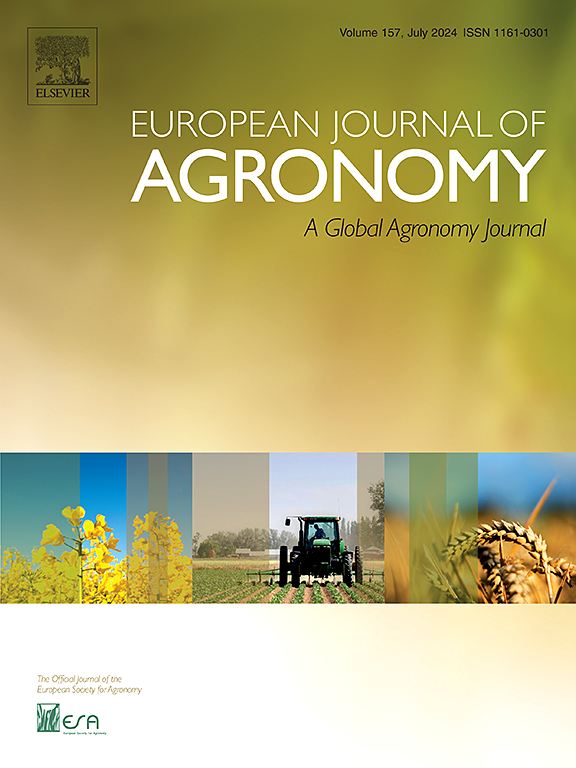盐灌和基因型对炎热干旱区硬粒小麦生长、产量和矿质浓度的联合影响
IF 4.5
1区 农林科学
Q1 AGRONOMY
引用次数: 0
摘要
在中东许多地区,硬粒小麦的种植只能在灌溉下进行,而且通常是用盐水灌溉。本研究评价了盐度、季节和基因型对硬粒小麦产量和品质的影响。在国际生物盐碱化农业中心(迪拜,阿联酋)的沙质土壤上,连续两季在不同灌溉盐度(2.6、10和15 dSm−1)下种植10个硬粒小麦基因型。对籽粒产量、生物量、株高、单株穗数、千粒重、叶绿素含量和籽粒同位素组成等性状进行了评价。盐度降低了籽粒的GY、农艺性状和叶绿素含量,增加了籽粒的δ13C和钠(Na)浓度。季节效应对谷粒灌浆期间的热浪影响显著,影响了谷粒生长、生物量、总重和一些矿物浓度。基因型效应在土壤肥力、农艺性状、氮素和大多数矿物质浓度上表现显著。GY与Na和δ13C均呈负相关,表明较好的水分状态和较低的Na积累与提高生产性能的基因型有关。然而,籽粒产量与大多数矿物质浓度之间不存在负相关关系。此外,籽粒中N和几种营养物质(P、Mg、Mn、Fe、Zn、Cu、S)的积累也遵循类似的模式,且呈正相关。我们认为,基因型变异对干旱高温地区盐灌下硬粒小麦产量的提高和矿物质含量的调节至关重要。本文章由计算机程序翻译,如有差异,请以英文原文为准。
Combined effects of saline irrigation and genotype on the growth, grain yield and mineral concentration of durum wheat in hot arid areas
Durum wheat cultivation in many parts of the Middle East is viable only under irrigation, often with saline water. This study evaluated the effects of salinity, season, and genotype on durum wheat grain yield and quality. Ten durum wheat genotypes were grown for two consecutive seasons under different irrigation salinities (2.6, 10, and 15 dSm−1) in sandy soils at the International Center for Biosaline Agriculture (Dubai, UAE). Various traits were evaluated, including grain yield (GY), biomass, plant height, number of spikes per plant, thousand grain weight (TGW), chlorophyll content, and grain isotope composition. Salinity reduced GY, agronomic traits, and chlorophyll content, while increasing δ13C and sodium (Na) concentration in grains. The season effect significantly impacted GY, biomass, TGW, and some mineral concentrations, potentially due to heat waves during grain filling. The genotypic effect was significant for GY, agronomic traits, and concentrations of nitrogen and most minerals. A negative phenotypic correlation was found between GY and both Na and δ13C, suggesting that better water status and lower Na accumulation were linked to genotypes with improved performance. However, there was no negative trade-off across genotypes between grain yield and concentrations of most minerals. Moreover, the accumulation of N and several nutrients (P, Mg, Mn, Fe, Zn, Cu, S) in grains followed a similar pattern, with positive correlations observed. We conclude that genotypic variability is crucial to improving yield and modulating mineral content in durum wheat grown under saline irrigation in hot arid areas.
求助全文
通过发布文献求助,成功后即可免费获取论文全文。
去求助
来源期刊

European Journal of Agronomy
农林科学-农艺学
CiteScore
8.30
自引率
7.70%
发文量
187
审稿时长
4.5 months
期刊介绍:
The European Journal of Agronomy, the official journal of the European Society for Agronomy, publishes original research papers reporting experimental and theoretical contributions to field-based agronomy and crop science. The journal will consider research at the field level for agricultural, horticultural and tree crops, that uses comprehensive and explanatory approaches. The EJA covers the following topics:
crop physiology
crop production and management including irrigation, fertilization and soil management
agroclimatology and modelling
plant-soil relationships
crop quality and post-harvest physiology
farming and cropping systems
agroecosystems and the environment
crop-weed interactions and management
organic farming
horticultural crops
papers from the European Society for Agronomy bi-annual meetings
In determining the suitability of submitted articles for publication, particular scrutiny is placed on the degree of novelty and significance of the research and the extent to which it adds to existing knowledge in agronomy.
 求助内容:
求助内容: 应助结果提醒方式:
应助结果提醒方式:


